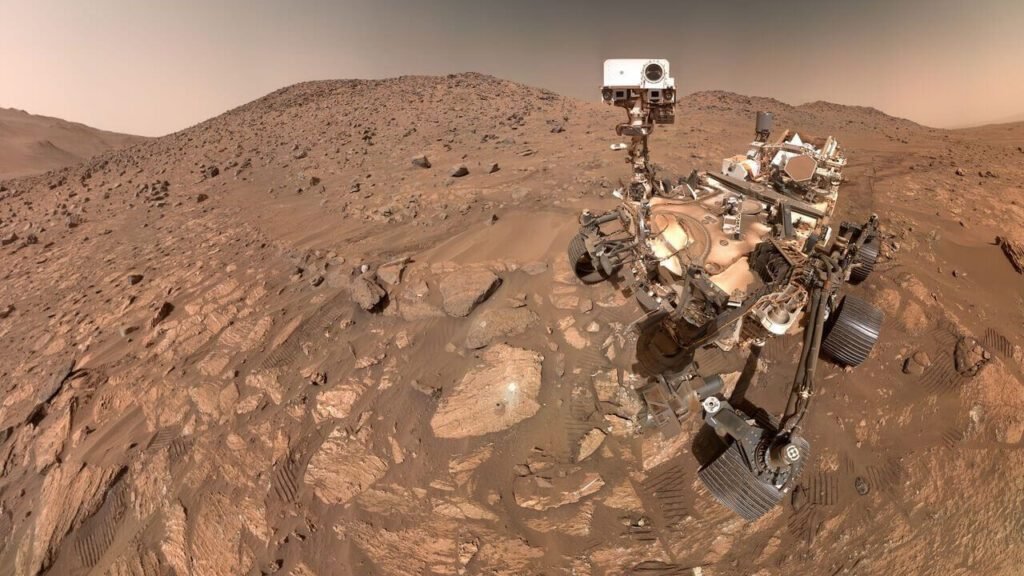NASA has announced a discovery that has amazed scientists and space enthusiasts worldwide. The findings suggest the strongest signs of life ever detected on the Red Planet. Using the Perseverance rover, researchers studied a rock called the Cheyava Falls rock in Jezero Crater. These investigations reveal clues about microbial life on Mars that may have existed billions of years ago. The presence of organic carbon on Mars, combined with chemical patterns in Martian minerals, shows a biological potential that has never been this clear before.
This discovery gives a new perspective on Mars habitability. The rock samples resemble an ancient riverbed on Mars, which may have carried water and nutrients, helping microbes survive. Patterns called leopard spots and poppy seeds on the rocks indicate complex chemical reactions produced by microbes, possibly leaving behind hydrated iron phosphate and iron sulfide formation. These findings have triggered excitement about upcoming projects like the Mars Sample Return mission, which will allow laboratory analysis on Earth for more confirmation.
NASA Confirms Potential Signs of Life on Mars
NASA has confirmed potential signs of life in a groundbreaking announcement. The Perseverance rover collected samples from the Cheyava Falls rock in Jezero Crater, revealing chemical reactions produced by microbes. These reactions show the rock could have supported microbial life on Mars. Scientists emphasize the importance of verifying these results through peer-reviewed study and Nature journal publication before making definitive claims.
The discovery highlights the biological potential of Mars. Using high-resolution Mars images, researchers detected:
- Oxidized iron in sediment layers
- Sulfur and phosphorus compounds indicating possible microbial activity
- Microbially influenced minerals resembling Earth fossils
- Evidence of a microbially influenced environment
- Potential for energy conversion by microbes billions of years ago
Exploring the Martian Mudstone Layers
The Cheyava Falls rock sits in layered mudstone in Jezero Crater. These layers formed in an ancient riverbed on Mars. The minerals preserved in the mudstone, such as Vivianite and greigite, suggest water once flowed through these regions. Scientists say the patterns on the rock, including leopard spots and poppy seeds, could result from chemical reactions produced by microbes, or non-biological mineral formation (read more).
The Perseverance rover analyzed these layers with its payload. While there are rover payload limitations, it still detected organic carbon on Mars. These mudstone layers offer strong evidence of Mars habitability in the past.
| Mineral Detected | Possible Origin | Notes |
| Vivianite | Microbial activity | Found in water-rich environments on Earth |
| Greigite | Iron-sulfur reactions | Can form biologically or abiotically |
| Hydrated iron phosphate | Microbial metabolism | Often associated with ancient microbes |
Key Findings from Martian Mudstone:
- Preserved chemical layers indicate long-term water activity
- Microbially influenced minerals suggest past biological activity
- Patterns of leopard spots and poppy seeds are similar to Earth microbial signatures
- Potential habitats for microbial life on Mars identified
Microbial Fingerprints: Earth Comparisons
Scientists compared Martian minerals to Earth analogs to understand the biological potential. On Earth, similar hydrated iron phosphate and iron sulfide formation result from energy conversion by microbes in water-rich environments. By studying these patterns, researchers can detect signs of life without directly observing microbes.
In addition, laboratory studies show that chemical reactions produced by microbes leave unique leopard spots and poppy seeds patterns. Earth microbes in similar rocks can create microbially influenced minerals, proving the microbially influenced environment hypothesis.
| Comparison Factor | Mars Findings | Earth Analog |
| Mineral Composition | Vivianite, Greigite | Iron phosphate and iron sulfide deposits |
| Microbial Patterns | Leopard spots and poppy seeds | Microbial fossil traces in riverbeds |
| Water Activity | Ancient riverbed evidence | Wet sediment formations on Earth |
Chemical Clues Hint at Ancient Martian Life

The Cheyava Falls rock contains oxidized iron, sulfur and phosphorus compounds, and other organics that point toward microbial life on Mars. These chemical reactions produced by microbes may have left behind hydrated iron phosphate. Some patterns could also be from non-biological mineral formation, but the combination of markers strengthens the evidence.
Advanced instruments on the Perseverance rover captured high-resolution Mars images, revealing tiny microbially influenced minerals. These include Vivianite and greigite, which on Earth are often linked to ancient microbes.
Chemical Indicators of Life:
- Organic carbon on Mars indicating potential biological matter
- Oxidized iron and mineral layering suggesting aqueous activity
- Sulfur and phosphorus compounds associated with microbial metabolism
- Hydrated iron phosphate pointing to chemical reactions produced by microbes
Why Scientists Remain Cautious About Definitive Proof
Despite these exciting findings, researchers remain cautious. Rover payload limitations prevent collecting all data necessary to confirm life. Some mineral patterns may form naturally, which scientists call non-biological mineral formation. Careful peer-reviewed study is essential before claiming that life existed.
The Mars Sample Return mission will play a key role in verifying the biological potential of these rocks. Until samples reach Earth and undergo laboratory analysis on Earth, scientists cannot definitively prove microbial life on Mars.
Reasons for Caution:
- Rover instruments cannot analyze every microscopic detail
- Non-biological mineral formation could mimic microbial patterns
- Peer-reviewed study ensures scientific reliability
- Sample return needed for full laboratory analysis on Earth
Implications for Mars Habitability and Future Missions
If confirmed, the findings suggest Mars habitability existed in the past. The presence of organic carbon on Mars, oxidized iron, and sulfur and phosphorus compounds shows that the planet could have supported microbial life on Mars. These discoveries reshape our understanding of ancient water on Mars and microbially influenced minerals.
Future missions will focus on regions like Neretva Vallis and other ancient riverbeds on Mars. The upcoming Mars Sample Return mission aims to collect these rocks for detailed analysis.
Important Takeaways for Mars Exploration:
- Past Mars habitability is strongly suggested
- Regions like Neretva Vallis hold high potential for microbial fossils
- Sample return missions are critical for confirming biological potential
- Chemical analysis could validate energy conversion by microbes
The Perseverance Rover’s Role in the Discovery
The Perseverance rover is central to this breakthrough. Equipped with advanced instruments, it collected samples from the Cheyava Falls rock and analyzed Martian minerals in Jezero Crater. Its findings revealed leopard spots and poppy seeds, hydrated iron phosphate, and iron sulfide formation, pointing toward microbially influenced minerals.
Despite rover payload limitations, it provided invaluable data for future peer-reviewed study. NASA emphasizes that this marks a major step toward understanding microbial life on Mars.
Perseverance Rover Highlights:
- High-resolution imaging for detailed Martian minerals study
- Collected samples from Cheyava Falls rock
- Detected microbially influenced minerals and patterns
- Supports Mars Sample Return mission objectives
Next Steps in the Search for Martian Life
NASA plans more exploration to confirm the signs of life. The Mars Sample Return mission will bring samples from Cheyava Falls rock to Earth for laboratory analysis on Earth. Scientists will examine organic carbon on Mars, microbially influenced minerals, and potential chemical reactions produced by microbes to confirm biological potential.
Researchers also plan to explore other ancient riverbeds on Mars and Neretva Vallis. These regions could hold similar Martian minerals and microbially influenced environments.
Next Steps:
- Conduct detailed laboratory analysis on Earth
- Explore Neretva Vallis and other riverbed areas
- Confirm microbial life on Mars through chemical and mineral analysis
- Prepare for international collaboration on Mars habitability studies
Read more latest blogs here:
iOS 26 Launch Date Confirmed: Global Release September 15
Points Table Asia Cup 2025 Today: Latest Standings Update
Charlie Kirk Suspect Tyler Robinson Arrested After Confession
Conclusions
NASA’s findings at Cheyava Falls rock provide the strongest signs of life on Mars. With the Perseverance rover and upcoming Mars Sample Return mission, scientists hope to confirm whether microbial life on Mars once thrived. The presence of hydrated iron phosphate, iron sulfide formation, and sulfur and phosphorus compounds hints at a microbially influenced environment that may have existed billions of years ago. These discoveries mark a milestone in the quest to understand Mars habitability and the biological potential of our neighboring planet.
Zainab Farooq is a dedicated reporter and celebrity wealth analyst with Pakistan Coverage, committed to bringing readers timely and accurate information across diverse topics. With a passion for storytelling and fact-based reporting, she covers everything from celebrity net worth insights and entertainment industry analysis to local Pakistani developments and global trends, ensuring readers stay informed about the stories that shape our world.




